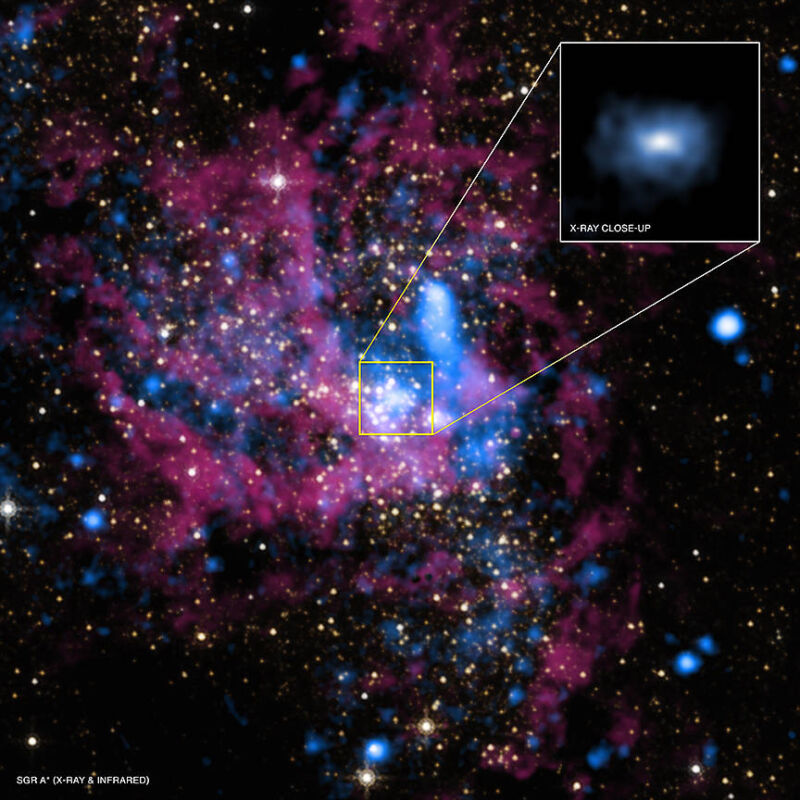
Supermassive black holes are ravenous. Clumps of dust and gas are prone to being disrupted by the turbulence and radiation when they are pulled too close. So why are some of them orbiting on the edge of the Milky Way’s own supermassive monster, Sgr A*? Maybe these mystery blobs are hiding something.
After analyzing observations of the dusty objects, an international team of researchers, led by astrophysicist Florian Peißker of the University of Cologne, have identified these clumps as potentially harboring young stellar objects (YSOs) shrouded by a haze of gas and dust. Even stranger is that these infant stars are younger than an unusually young and bright cluster of stars that are already known to orbit Sgr A*, known as the S-stars.
Finding both of these groups orbiting so close is unusual because stars that orbit supermassive black holes are expected to be dim and much more ancient. Peißker and his colleagues “discard the en vogue idea to classify [these] objects as coreless clouds in the high energetic radiation field of the supermassive black hole Sgr A*,” as they said in a study recently published in Astronomy & Astrophysics.
More than just space dust
To figure out what the objects near Sgr A* might be the, researchers needed to rule out things they weren’t. Embedded in envelopes of gas and dust, they maintain especially high temperatures, do not evaporate easily, and each orbits the supermassive black hole alone.
The researchers determined their chemical properties from the photons they emitted, and their mid- and near-infrared emissions were consistent with those of stars. They used one of them, object G2/DSO, as a case study to test their ideas about what the objects might be. The high brightness and especially strong emissions of this object make it the easiest to study. Its mass is also similar to the masses of known low-mass stars.
YSOs are low-mass stars that have outgrown the protostar phase but have not yet developed into main sequence stars, with cores that fuse hydrogen into helium. These objects like YSO candidates because they couldn’t possibly be clumps of gas and space dust. Gaseous clouds without any objects inside to hold them together via gravity could not survive so close to a supermassive black hole for long. Its intense heat causes the gas and dust to evaporate rather quickly, with heat-excited particles crashing into each other and flying off into space.
The team figured out that a cloud comparable in size to G2/DSO would evaporate in about seven years. A star orbiting at the same distance from the supermassive black hole would not be destroyed nearly as fast because of its much higher density and mass.
Another class of object that the dusty blobs could hypothetically be—but are not—is a compact planetary nebula or CPN. These nebulae are the expanding outer gas envelopes of small to medium stars in their final death throes. While CPNs have some features in common with stars, the strength of a supermassive black hole’s gravity would easily detach their gas envelopes and tear them apart.
It is also unlikely that the YSOs are binary stars, even though most stars form in binary systems. The scorching temperatures and turbulence of SGR A* would likely cause stars that were once part of binaries to migrate.
Seeing stars
Further observations determined that some of the dust-obscured objects are nascent stars, and while others are thought to be stars of some kind, but haven’t been definitively identified.
The properties that made G2/DSO an exceptional case study are also the reason it has been identified as a YSO. D2 is another high-luminosity object about as massive as a low-mass star, which is easy to observe in the near- and mid-infrared. D3 and D23 also have similar properties. These are the blobs near the black hole that the researchers think are most likely to be YSOs.
There are other candidates that need further analysis. These include additional objects that may or may not be YSOs, but still show stellar characteristics: D3.1 and D5, which are difficult to observe. The mid-infrared emissions of D9 are especially low when compared to the other candidates, but it is still thought to be some type of star, though possibly not a YSO. Objects X7 and X8 both exhibit bow shock—the shockwave that results from a star’s stellar wind pushing against other stellar winds. Whether either of these objects is actually a YSO remains unknown.
Where these dusty objects came from and how they formed is unknown for now. The researchers suggest that the objects formed together in molecular clouds that were falling toward the center of the galaxy. They also think that, no matter where they were born, they migrated towards Sgr A*, and any that were in binary systems were separated by the black hole’s immense gravity.
While it is unlikely that the YSOs and potential YSOs originated in the same cluster as the slightly older S-stars, they still might be related in some way. They might have experienced similar formation and migration journeys, and the younger stars might ultimately reach the same stage.
“Speculatively, the dusty sources will evolve into low-mass S stars,” Peißker’s team said in the same study.
Even black holes look better with a necklace of twinkling diamonds.
Astronomy and Astrophysics, 2024. DOI: 10.1051/0004-6361/202449729
https://arstechnica.com/?p=2035208

